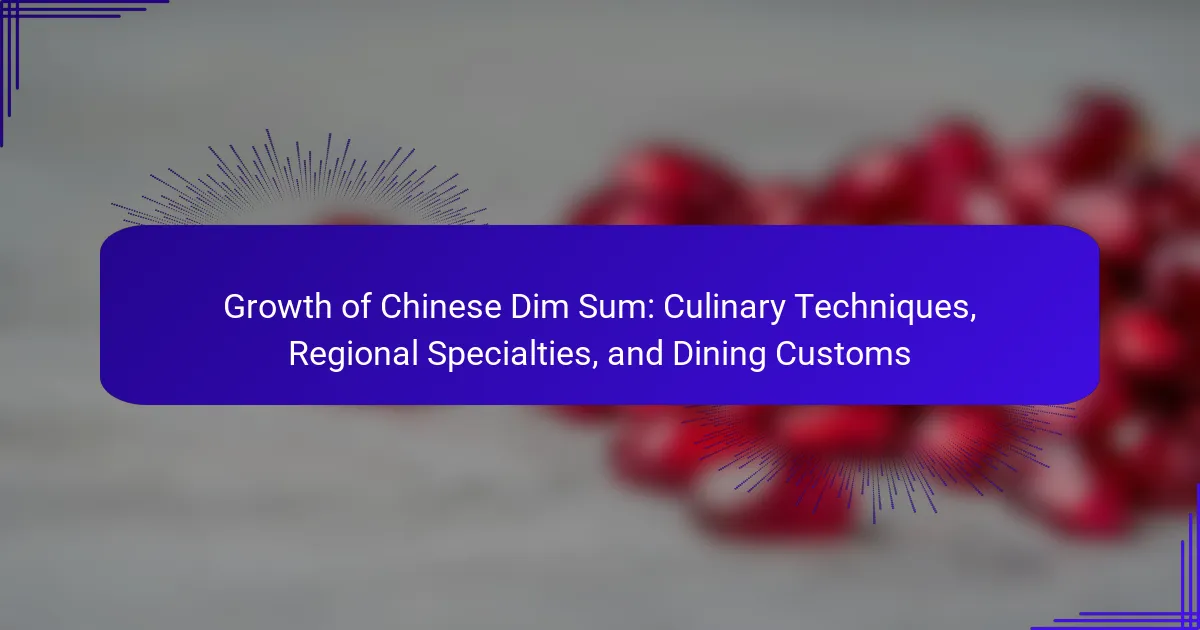
What is the significance of Chinese Dim Sum in culinary culture?
Chinese Dim Sum holds significant cultural importance as a traditional culinary practice. It embodies the art of small, shared dishes, promoting social interaction during meals. Originating in Guangdong province, Dim Sum has evolved into a global phenomenon. The practice of Yum Cha, or tea tasting, complements Dim Sum, enhancing its cultural experience. Historically, Dim Sum was served to travelers along trade routes. Today, it symbolizes hospitality and community in Chinese culture. The variety of dishes reflects regional ingredients and cooking techniques. Dim Sum’s significance lies in its role in family gatherings and celebrations, reinforcing cultural heritage.
How has Chinese Dim Sum evolved over time?
Chinese Dim Sum has evolved significantly over time. Initially, it began as a simple snack for travelers along the Silk Road. Over centuries, it transformed into a diverse culinary tradition in Guangdong Province. During the Qing Dynasty, Dim Sum became a formalized dining experience, with tea houses serving a variety of small dishes. The introduction of steamers and bamboo baskets enhanced the cooking methods. In the 20th century, Dim Sum spread globally, adapting to local tastes and ingredients. Today, it features both traditional and modern interpretations, reflecting regional specialties. The evolution of Dim Sum showcases its rich history and cultural significance in Chinese cuisine.
What historical factors contributed to the growth of Dim Sum?
Dim Sum grew due to several historical factors. The practice originated in the Cantonese region during the Song Dynasty. Tea houses began serving small dishes to complement tea drinking. This created a social dining culture, encouraging communal eating. The Silk Road facilitated trade, bringing diverse ingredients and culinary influences. Migration patterns spread Dim Sum to various regions, adapting local flavors. The industrial revolution led to urbanization, increasing demand for convenient dining options. Today, Dim Sum is celebrated globally, reflecting its rich history and cultural significance.
How did regional influences shape the development of Dim Sum?
Regional influences significantly shaped the development of Dim Sum through diverse culinary techniques and local ingredients. Each region in China contributed unique flavors and dishes to the Dim Sum repertoire. For example, Cantonese Dim Sum features steamed dumplings and buns, while Northern regions incorporate more flour-based items. The availability of local ingredients also played a crucial role. Coastal areas utilized seafood, while inland regions focused on meats and vegetables. Historical trade routes introduced new spices and cooking methods, enhancing the variety of Dim Sum. Cultural practices, such as tea drinking in Guangdong, influenced the dining customs associated with Dim Sum. These regional variations created a rich tapestry of flavors and styles, making Dim Sum a beloved culinary tradition across China.
What are the core culinary techniques used in making Dim Sum?
The core culinary techniques used in making Dim Sum include steaming, frying, baking, and boiling. Steaming is the most traditional method, preserving the moisture and flavor of the ingredients. Frying is often used for dishes like spring rolls and dumplings, providing a crispy texture. Baking is applied to items such as egg tarts, offering a flaky crust. Boiling is commonly used for certain types of dumplings, which are then often served with dipping sauces. Each technique contributes to the unique texture and flavor profiles characteristic of Dim Sum.
What are the primary cooking methods for Dim Sum?
The primary cooking methods for Dim Sum include steaming, frying, and baking. Steaming is the most common method and preserves the moisture and flavor of the ingredients. Many Dim Sum dishes, such as dumplings and buns, are typically served steamed. Frying is used for items like spring rolls and potstickers, providing a crispy texture. Baking is less common but is used for certain pastries and baked buns. These methods highlight the diverse textures and flavors that characterize Dim Sum. Each technique contributes to the overall dining experience and reflects regional culinary traditions.
How do different techniques affect the texture and flavor of Dim Sum?
Different techniques significantly influence the texture and flavor of Dim Sum. Steaming, for example, preserves moisture and results in a tender texture. This method enhances the natural flavors of ingredients, making them more pronounced. Frying, on the other hand, creates a crispy exterior while keeping the interior moist. This contrast in texture adds complexity to the overall dining experience. Boiling can yield a softer, more delicate texture, which is ideal for certain dumplings. Each technique also affects flavor absorption; for instance, frying can incorporate additional flavors from oils and seasonings. Historical practices indicate that the choice of technique is often tied to regional preferences, further diversifying Dim Sum.

What are the regional specialties of Chinese Dim Sum?
Chinese Dim Sum features regional specialties that vary across different areas. In Guangdong, the focus is on steamed dumplings like har gow and siu mai. Shanghai is known for its soup dumplings, or xiao long bao, which are filled with broth. In Hong Kong, dim sum includes a variety of dishes served on carts, emphasizing small portions of different foods. Sichuan dim sum often incorporates spicy flavors and ingredients. Finally, Beijing offers specialties like jiaozi, or potstickers, which are pan-fried dumplings. Each region showcases unique ingredients and cooking methods, reflecting local culinary traditions.
How do regional variations influence Dim Sum offerings?
Regional variations significantly influence Dim Sum offerings by introducing diverse ingredients and cooking techniques. In Guangdong, traditional Dim Sum features items like shrimp dumplings and pork buns. Conversely, regions like Shanghai emphasize pan-fried dumplings and sweet buns.
The use of local ingredients also alters the flavor profiles. For example, Sichuan Dim Sum incorporates spicy elements, while Cantonese versions tend to be milder. Additionally, cultural practices shape presentation and dining customs. In some areas, Dim Sum is enjoyed as a brunch, while in others, it is served during special occasions.
These regional distinctions reflect the rich culinary heritage across China. They showcase how geography and local tastes shape food traditions.
What are the most popular Dim Sum dishes in Cantonese cuisine?
The most popular Dim Sum dishes in Cantonese cuisine include Har Gao, Siu Mai, and Char Siu Bao. Har Gao are shrimp dumplings known for their translucent skin. Siu Mai are open-topped pork dumplings often garnished with crab roe. Char Siu Bao are steamed buns filled with sweet barbecued pork. Other notable dishes are Cheung Fun, which are rice noodle rolls, and Egg Tarts, a flaky pastry filled with egg custard. These dishes are staples in Dim Sum restaurants and are enjoyed during tea service. Their popularity stems from both tradition and flavor, making them essential to Cantonese dining culture.
What unique Dim Sum styles are found in other regions of China?
Unique Dim Sum styles found in other regions of China include Cantonese, Shanghainese, and Sichuan styles. Cantonese Dim Sum is known for its variety of steamed dumplings and buns. Shanghainese Dim Sum features soup dumplings, known as xiaolongbao, filled with broth. Sichuan Dim Sum incorporates bold flavors and spicy ingredients, offering dishes like spicy wontons. Each style reflects the local culinary traditions and ingredients available. For example, the use of fresh seafood is prominent in Cantonese Dim Sum. In contrast, Shanghainese cuisine emphasizes the use of sweet and savory flavors. Sichuan Dim Sum often includes chili oil and garlic for heat. These regional variations showcase the diversity of Dim Sum across China.
What ingredients are commonly used in regional Dim Sum specialties?
Common ingredients in regional Dim Sum specialties include shrimp, pork, chicken, and various vegetables. Dumplings often feature a combination of these proteins with seasonings like ginger and garlic. Rice flour is a key component in many wrappers. Bamboo shoots and water chestnuts add crunch to fillings. Regional variations may include unique ingredients such as scallops in Cantonese dim sum or taro in Hong Kong. Additionally, some specialties incorporate mushrooms for umami flavor. These ingredients reflect the diverse culinary traditions across different regions of China.
How does the use of local ingredients enhance Dim Sum flavors?
The use of local ingredients enhances Dim Sum flavors by incorporating fresh, regional tastes. Local ingredients reflect the unique culinary heritage of the area. This practice allows chefs to create dishes that resonate with local palates. Freshness improves the overall quality and taste of the Dim Sum. For example, using locally sourced vegetables can provide vibrant flavors and textures. Additionally, local meats can enhance the dish’s richness and authenticity. Studies show that regional ingredients can elevate the dining experience by connecting diners to local culture. This approach fosters a sense of community and tradition in the culinary landscape.
What are some rare ingredients found in specific Dim Sum dishes?
Some rare ingredients found in specific Dim Sum dishes include bird’s nest, abalone, and black truffle. Bird’s nest is used in sweet soups and is made from the saliva of cave-dwelling birds. Abalone is often featured in steamed dumplings, offering a unique oceanic flavor. Black truffle is sometimes incorporated into certain dumplings, adding an earthy richness. These ingredients are not commonly found in everyday cooking, making them special in Dim Sum cuisine. Their rarity contributes to the luxurious experience of enjoying Dim Sum.

What dining customs are associated with enjoying Dim Sum?
Dim Sum dining customs involve sharing small plates of food among a group. This communal style encourages social interaction and conversation. Traditionally, diners order a variety of dishes to sample different flavors. The meal often includes tea, which is served throughout the dining experience. In many settings, carts filled with dishes circulate around the dining area. Diners select items directly from these carts. The practice of using chopsticks or small plates is common. It is customary to leave some food on the plate as a sign of satisfaction.
How is Dim Sum traditionally served and consumed?
Dim Sum is traditionally served in small, shareable portions. It is typically presented in bamboo steamers or on small plates. Diners usually order multiple dishes to share among the table. This communal style encourages social interaction during meals. Tea is often served alongside Dim Sum, enhancing the dining experience. The practice of enjoying Dim Sum is commonly associated with brunch or lunch. Historically, it originated from Cantonese cuisine. Dim Sum reflects a variety of flavors and cooking techniques.
What role does tea play in the Dim Sum dining experience?
Tea serves as a crucial component in the Dim Sum dining experience. It enhances the meal’s flavors and aids in digestion. Traditionally, tea is consumed throughout the meal, complementing various dishes. Different types of tea, such as Pu-erh and Oolong, are often chosen based on the food served. The act of pouring tea is a ceremonial gesture, symbolizing hospitality. Additionally, tea culture is deeply embedded in Chinese dining customs. Many restaurants offer tea as part of the dining experience, reflecting its importance. Overall, tea enriches the enjoyment and social aspect of Dim Sum.
How do dining customs vary across different regions during Dim Sum meals?
Dining customs during Dim Sum meals vary significantly across regions. In Hong Kong, for instance, diners often enjoy a bustling atmosphere with carts of dishes circulating around the restaurant. This allows for a communal dining experience where sharing is encouraged. In contrast, in Guangzhou, a more traditional setting is common, where Dim Sum is typically served in a more formal manner.
In Shanghai, the focus may shift to a more refined presentation, with an emphasis on delicate flavors and artistic plating. Meanwhile, in the United States, Dim Sum meals often adopt a fusion approach, incorporating local ingredients and flavors.
Additionally, meal timing differs; in many regions of China, Dim Sum is traditionally a brunch or late-morning meal, while in Western countries, it may be served at various times throughout the day. These regional variations reflect cultural preferences and culinary traditions associated with Dim Sum.
What etiquette should be observed when dining on Dim Sum?
When dining on Dim Sum, it is important to observe several key etiquette rules. First, wait for the host to begin the meal before you start eating. This shows respect for your dining companions. Second, use chopsticks properly; do not stick them upright in rice, as it resembles incense offerings for the deceased. Third, share dishes among the table, as Dim Sum is meant to be enjoyed communally. Fourth, when pouring tea, serve others before filling your own cup. This act of generosity is a common courtesy. Fifth, it is polite to tap the table with your fingers when thanking someone who pours tea for you. This gesture signifies appreciation. Lastly, refrain from discussing sensitive topics during the meal to maintain a pleasant atmosphere. Observing these etiquettes enhances the dining experience and honors the cultural significance of Dim Sum.
What are common practices for sharing Dim Sum dishes at the table?
Common practices for sharing Dim Sum dishes at the table include using chopsticks or small serving utensils. Diners typically take small portions from shared plates. This encourages communal eating and enhances social interaction. It is customary to serve dishes in the center of the table for easy access. Guests often rotate dishes to ensure everyone can try different items. Sharing is a key aspect of Dim Sum culture, promoting a sense of togetherness. Additionally, diners may order multiple dishes to sample a variety of flavors. This practice reflects the diverse offerings available in Dim Sum cuisine.
How can diners enhance their Dim Sum experience through cultural understanding?
Diners can enhance their Dim Sum experience through cultural understanding by learning about its origins and customs. Dim Sum originated in Guangdong province and reflects Cantonese culinary traditions. Understanding the significance of tea pairing can elevate the dining experience. In Chinese culture, tea is often served with Dim Sum to aid digestion and enhance flavors. Diners should also be aware of the etiquette involved, such as sharing dishes and using chopsticks properly. This practice fosters a communal dining atmosphere. Familiarity with regional specialties can also enrich the experience. For example, knowing that Har Gow is a shrimp dumpling while Siu Mai is pork-based can guide selections. Engaging with staff about dish recommendations can further enhance understanding and enjoyment. This cultural appreciation leads to a more immersive and respectful dining experience.
What tips can enhance the Dim Sum dining experience?
To enhance the Dim Sum dining experience, consider these tips. First, arrive early to enjoy freshly made dishes. Many Dim Sum restaurants serve items in limited quantities. Second, share a variety of dishes with your dining companions. This allows for a broader tasting experience. Third, pair your meal with traditional teas, such as Pu-erh or Jasmine. These complement the flavors of Dim Sum. Fourth, try to understand the menu. Familiarize yourself with common Dim Sum items like dumplings, buns, and rolls. Fifth, ask for recommendations from the staff. They can guide you to popular or unique offerings. Lastly, enjoy the communal atmosphere. Dim Sum is meant to be a social dining experience, enhancing enjoyment through interaction.
How can one choose the best Dim Sum dishes at a restaurant?
To choose the best Dim Sum dishes at a restaurant, consider the variety and freshness of offerings. Look for popular items like siu mai, har gow, and char siu bao. Observe the quality of ingredients; fresh seafood and vegetables indicate a reputable kitchen. Pay attention to the presentation; well-plated dishes often reflect care in preparation. Consult the restaurant’s specialties, as many establishments have signature Dim Sum items. Check reviews or ask staff for recommendations; experienced servers can guide you to the best choices. Finally, consider the cooking methods; steamed and pan-fried options typically offer distinct flavors and textures.
What are some common mistakes to avoid when enjoying Dim Sum?
Common mistakes to avoid when enjoying Dim Sum include overordering dishes. Many diners mistakenly think they should try everything at once. This can lead to food waste and an overwhelming dining experience. Another mistake is not using chopsticks correctly. Improper use can lead to messiness and discomfort. Additionally, ignoring the tea selection is a frequent error. Tea enhances the flavors of Dim Sum and aids digestion. Failing to pace oneself is also common. Eating too quickly can diminish the enjoyment of each dish. Lastly, not sharing food can detract from the communal dining experience that Dim Sum promotes.
The main entity of this article is Chinese Dim Sum, a traditional culinary practice with significant cultural importance. The article explores the growth of Dim Sum, highlighting its historical evolution, core culinary techniques, and regional specialties. It discusses how various cooking methods and local ingredients shape the texture and flavor of Dim Sum, as well as the dining customs and etiquette associated with enjoying this communal meal. Additionally, the article emphasizes the role of tea in enhancing the Dim Sum experience and provides tips for selecting dishes at restaurants.
